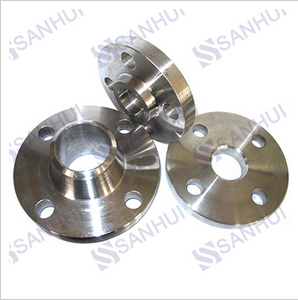Classification

The casting surface characteristics of titanium flange casting
Submitted by admin on 09/29/2014
The casting surface characteristics formed in the process of titanium flange casting depend on the surface profile (roughness, clarity, the mechanical penetration etc.) in liquid titanium replication mold and the formation of macro roughness (cold insulation, flow mark, the surface pores, cracks, inclusions and fold) tendencies, and the chemical reaction tendency (casting scar, contamination layer, chemical bonded sand etc.) of liquid titanium and mould.
The measurement of the titanium flange casting surface quality depends on the surface roughness and the macroscopic roughness. The surface roughness is the uneven degree of casting surface profile. Its measurement unit is microns (Ra or Rz). Casting macro roughness refers to the micro concavo convex parts appeared on the casting surface, such as cold shut, flow mark, crack, surface hole and inclusion almost all lines of curvature. And they are visible to our naked eye.
Easy to form the flow mark and cold insulation is one of the characteristics of titanium flange casting. Another important measurement of the surface quality of titanium flange casting is the contamination layer thickness. It is directly related to the subsequent use of castings.
The influence factors of casting surface characteristics of the forming process of titanium flange casting are introduced as follows:
The surface quality of casting titanium flange depends largely on the surface quality and roughness and thermo chemical stability of casting mould. The surface layer material grain of casting is larger, and then the casting surface roughness is larger. The casting mould surface coarse skin grafting and thermal conductivity and wet ability of molten titanium casting mold, and the processing status before the casting mold casted, have great influence on surface quality of titanium flange casting.

.
The measurement of the titanium flange casting surface quality depends on the surface roughness and the macroscopic roughness. The surface roughness is the uneven degree of casting surface profile. Its measurement unit is microns (Ra or Rz). Casting macro roughness refers to the micro concavo convex parts appeared on the casting surface, such as cold shut, flow mark, crack, surface hole and inclusion almost all lines of curvature. And they are visible to our naked eye.
Easy to form the flow mark and cold insulation is one of the characteristics of titanium flange casting. Another important measurement of the surface quality of titanium flange casting is the contamination layer thickness. It is directly related to the subsequent use of castings.
The influence factors of casting surface characteristics of the forming process of titanium flange casting are introduced as follows:
The surface quality of casting titanium flange depends largely on the surface quality and roughness and thermo chemical stability of casting mould. The surface layer material grain of casting is larger, and then the casting surface roughness is larger. The casting mould surface coarse skin grafting and thermal conductivity and wet ability of molten titanium casting mold, and the processing status before the casting mold casted, have great influence on surface quality of titanium flange casting.

.
------分隔线----------------------------




